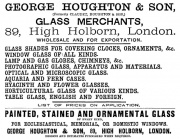George Houghton and Son











George Houghtons, glass merchants, maker of photographic equipment and wholesaler of photographic materials, of 89 High Holborn, London, and of Glasgow
1834 George Houghton joined Antoine Claudet to manage a glass warehouse in London, under the name Claudet and Houghton.
1839 After the announcement of the Daguerreotype process, Claudet secured a license directly from Daguerre and spent most of his time operating his own studio while Houghton began selling Daguerreotype requisites.
1876 It became George Houghton and Son
1892 Became George Houghton and Sons
1901 The company's headquarters at 88/89 High Holborn were called Ensign House in 1901
1903 Production of the roll film brand Ensign began. The first Ensign logo was a shop sign with the letter "N" inside, and was replaced in 1911 by the name ENSIGN written inside the British marine flag.
1903 the company was incorporated as George Houghton and Sons Ltd
1904 absorbed Holmes Brothers, maker of the Sanderson cameras, A. C. Jackson, Spratt Brothers and Joseph Levi and Co, to form Houghtons Ltd. The new company carried on the production of the smaller companies it had absorbed.
Early 1900s the company built a factory for the production of cameras at Fulbourn Road in Walthamstow. In 1908 this was the biggest British camera factory.
c.1910 Manufactured the Ticka miniature camera (disguised as a pocket established
1915 Houghtons Ltd and W. Butcher and Sons Ltd formed a joint venture Houghton-Butcher Manufacturing Co Ltd to share manufacturing facilities. The two companies continued to trade separately, and the camera designs remained distinct.
1926 The two trading companies merged to form Houghton-Butcher (Gt. Britain) Ltd., which established Ensign Ltd. as a selling arm in 1930.
See Also
Sources of Information
- Camerapedia [1]

